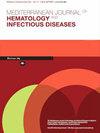SARS-CoV-2非结构蛋白2的新突变
IF 2
4区 医学
Q3 HEMATOLOGY
Mediterranean Journal of Hematology and Infectious Diseases
Pub Date : 2023-10-16
DOI:10.4084/mjhid.2023.059
引用次数: 0
摘要
背景:SARS-CoV-2基因组突变可能与免疫逃避、致病性和传播速度有关。我们的研究旨在评估存在于nsp2. 材料和方法:从100例COVID-19患者鼻咽拭子中提取RNA。采用nsp2特异性引物对所有样品进行RT-PCR。凝胶电泳后,将条带剪切、纯化并使用Sanger法进行测序。测序后,90个序列可用于进一步分析。生物信息学分析研究突变对蛋白质结构的影响,预测同源模型,系统发育树。 结果:患者平均年龄为 背景:SARS-CoV-2基因组突变可能与免疫逃避、致病性和传播速度有关。我们的研究旨在评估存在于nsp2. 材料和方法:从100例COVID-19患者鼻咽拭子中提取RNA。采用nsp2特异性引物对所有样品进行RT-PCR。凝胶电泳后,将条带剪切、纯化并使用Sanger法进行测序。测序后,90个序列可用于进一步分析。生物信息学分析研究突变对蛋白质结构的影响,预测同源模型,系统发育树。 结果:患者平均年龄51.08岁。结果显示,17个nsp2突变中有8个(R207C、T224I、G262V、T265I、K337D、N348S、G392D和I431M)是错义突变。在nsp2中也发现了一个缺失。在研究的nsp2错义突变中,K337D和G392D增加了结构稳定性,而其他突变则降低了结构稳定性。同源性设计模型表明,这些同源性与武汉- hu -1病毒的序列相当。结论:我们的研究表明,K337D和G392D突变调节了nsp2的稳定性,应该跟踪病毒的进化并更新疫苗的开发。51.08 s。结果显示,17个nsp2突变中有8个(R207C、T224I、G262V、T265I、K337D、N348S、G392D和I431M)是错义突变。在nsp2中也发现了一个缺失。在研究的nsp2错义突变中,K337D和G392D增加了结构稳定性,而其他突变则降低了结构稳定性。同源性设计模型表明,这些同源性与武汉- hu -1病毒的序列相当。结论:我们的研究表明,K337D和G392D突变调节了nsp2的稳定性,应该跟踪病毒的进化并更新疫苗的开发。本文章由计算机程序翻译,如有差异,请以英文原文为准。
NOVEL MUTATIONS IN THE NON-STRUCTURE PROTEIN 2 OF SARS-CoV-2
Background: Mutation in the genome of SARS-CoV-2 may play a role in immune evasion, pathogenicity and speed of its transmission. Our investigation aimed to evaluate the mutations that exist in the nsp2.
Materials and Method: RNA was extracted from nasopharyngeal swabs from 100 COVID-19 patients. RT-PCR was performed on all samples using nsp2 specific primers. Following gel electrophoresis, the bands were cut, purified, and sequenced using Sanger method. After sequencing, 90 sequences could be used for further analysis. Bioinformatics analysis was conducted to investigate the effect of mutations on protein structure, prediction of homology models, phylogeny tree.
Results: The patients' mean age wa
Background: Mutation in the genome of SARS-CoV-2 may play a role in immune evasion, pathogenicity and speed of its transmission. Our investigation aimed to evaluate the mutations that exist in the nsp2.
Materials and Method: RNA was extracted from nasopharyngeal swabs from 100 COVID-19 patients. RT-PCR was performed on all samples using nsp2 specific primers. Following gel electrophoresis, the bands were cut, purified, and sequenced using Sanger method. After sequencing, 90 sequences could be used for further analysis. Bioinformatics analysis was conducted to investigate the effect of mutations on protein structure, prediction of homology models, phylogeny tree.
Results: The patients' mean age was 51.08. The results revealed that 8 of the 17 nsp2 mutations (R207C, T224I, G262V, T265I, K337D, N348S, G392D, and I431M) were missense. One deletion was also found in nsp2. Among nsp2 missense mutations studied, K337D and G392D increased structural stability while the others decreased it. The homology-designed models demonstrated that the homologies were comparable to the sequences of the Wuhan-HU-1 virus.
Conclusion: Our study suggested that the mutations as K337D and G392D modulate the stability of nsp2 and tracking viral evolution should be implemented and vaccine development updated.
s 51.08. The results revealed that 8 of the 17 nsp2 mutations (R207C, T224I, G262V, T265I, K337D, N348S, G392D, and I431M) were missense. One deletion was also found in nsp2. Among nsp2 missense mutations studied, K337D and G392D increased structural stability while the others decreased it. The homology-designed models demonstrated that the homologies were comparable to the sequences of the Wuhan-HU-1 virus.
Conclusion: Our study suggested that the mutations as K337D and G392D modulate the stability of nsp2 and tracking viral evolution should be implemented and vaccine development updated.
求助全文
通过发布文献求助,成功后即可免费获取论文全文。
去求助
来源期刊

Mediterranean Journal of Hematology and Infectious Diseases
Medicine-Hematology
CiteScore
4.20
自引率
6.20%
发文量
113
审稿时长
12 weeks
期刊介绍:
Reciprocal interdependence between infectious and hematologic diseases (malignant and non-malignant) is well known. This relationship is particularly evident in Mediterranean countries. Parasitosis as Malaria, Leishmaniosis, B Hookworms, Teniasis, very common in the southeast Mediterranean area, infect about a billion people and manifest prevalently with anemia so that they are usually diagnosed mostly by experienced hematologist on blood or bone marrow smear. On the other hand, infections are also a significant problem in patients affected by hematological malignancies. The blood is the primary vector of HIV infection, which otherwise manifest with symptoms related to a reduction in T lymphocytes. In turn, infections can favor the insurgency of hematological malignancies. The causative relationship between Epstein-Barr virus infection, Helicobacter pylori, hepatitis C virus, HIV and lymphoproliferative diseases is well known.
 求助内容:
求助内容: 应助结果提醒方式:
应助结果提醒方式:


